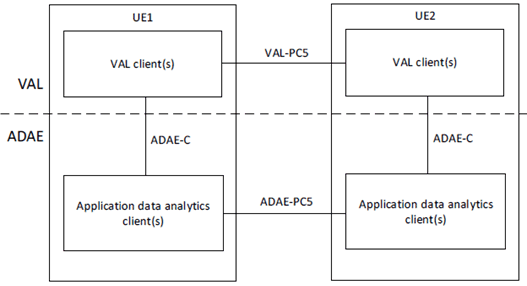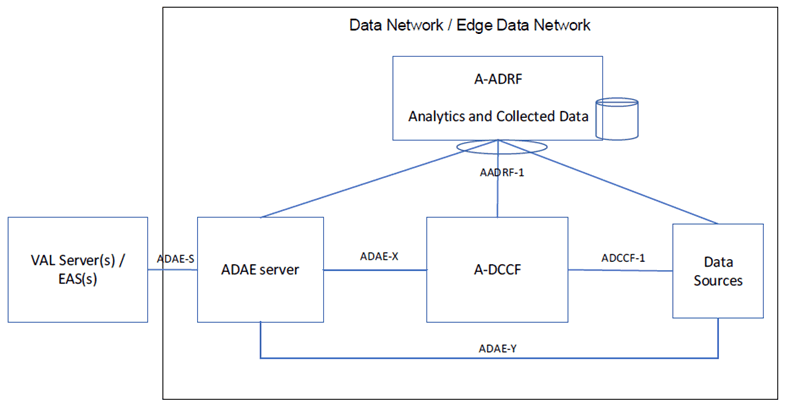Content for TR 23.700-36 Word version: 18.1.0
5.3.3 Off-network Functional Architecture
5.3.4 ADAE internal architecture based on 3GPP data analytics framework
...
...
5.3.3 Off-network Functional Architecture p. 15
Figure 5.3.3-1 illustrates the generic off-network functional model for ADAE.

In the vertical application layer, the VAL client of UE1 communicates with VAL client of UE2 over VAL-PC5 reference point. An application data analytics enablement client of UE1 interacts with the corresponding application data analytics enablement client of UE2 over ADAE-PC5 reference points. The UE1, if connected to the network via Uu reference point, can also act as a UE-to-network relay, to enable UE2 to access the VAL server(s) over the VAL-UU reference point.
If the ADAE server is deployed as SEAL server, the off network functional architecture is similar to SEAL off-network architecture (as specified in TS 23.434).
5.3.4 ADAE internal architecture based on 3GPP data analytics framework p. 15
In 3GPP SA2 (TS 23.288), the following entities have been defined as part of the data analytics framework:
- NWDAF provides network data analytics services at the 5GC
- DCCF coordinates the collection and distribution of data requested by NF/AF consumers. Data Collection Coordination is supported by a DCCF. Data Consumers can send requests for data to the DCCF rather than directly to the NF/AF Data Source.
- ADRF stores historical data and/or analytics, i.e., data and/or analytics related to past time period that has been obtained by the consumer. After the consumer obtains data and/or analytics, consumer may store historical data and/or analytics in an ADRF. Whether the consumer directly contacts the ADRF or goes via the DCCF or via the Messaging Framework is based on configuration.

Figure 5.3.4-1: Generic functional model based on network data analytics model
(⇒ copy of original 3GPP image)
(⇒ copy of original 3GPP image)
In this model, an Application layer - Data Collection and Coordination Function (A-DCCF) is used to fetch data or put data into an Application level entity (e.g. A-ADRF, Data Source). Such A-DCCF coordinates the collection and distribution of data requested by ADAE server (over ADCCF-1, ADAE-X). ADAE server can also directly interact with the Data Sources via ADAE-Y.
Also, Application layer - Analytics and Data Repository Function (A-ADRF) can be used to store historical data and/or analytics, i.e. data and/or analytics related to past time period that has been obtained by the ADAE server (via AADRF-1) or other NFs/NWDAF. ADAE server can also fetch historical data from ADRF. Whether the ADAE server directly contacts the ADRF or goes via the A-DCCF is based on configuration.
Data Sources can be 5GS data sources (5GC, OAM) or enablement layer data sources (SEAL, EEL) or external data sources at the DN side (VAL server/EAS) and VAL UEs. A-DCCF and A-ADRF can be used only for interacting with certain data sources (e.g. 5GC, OAM) based on configuration, and can be hidden from the VAL layer.